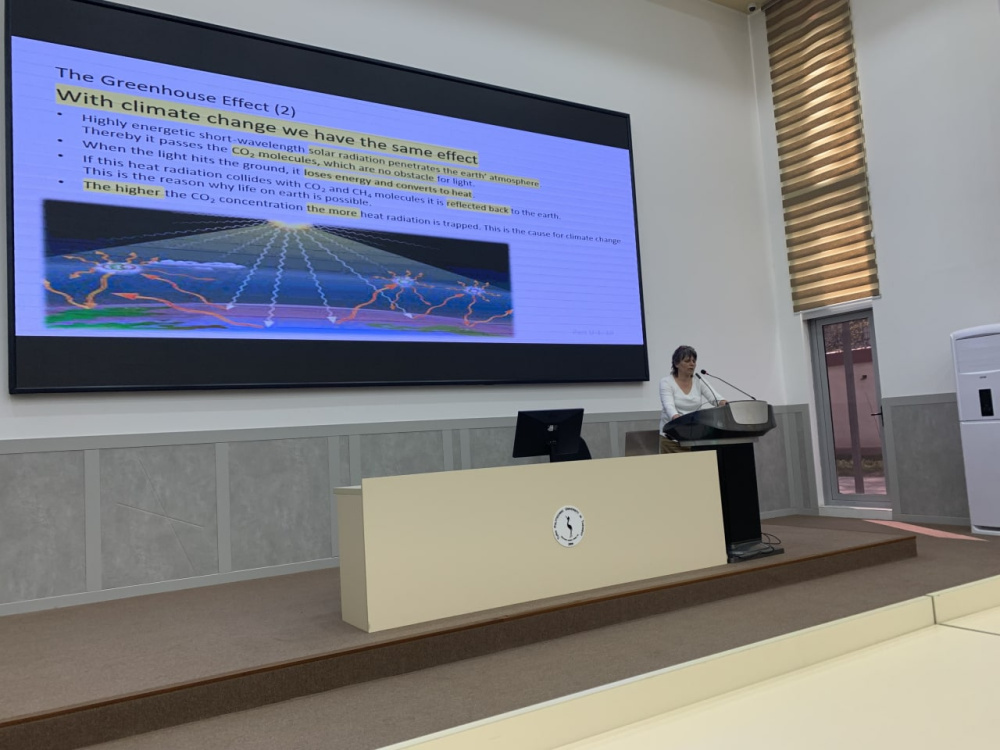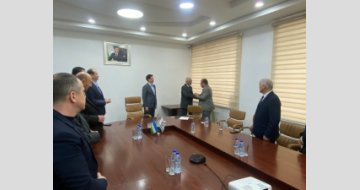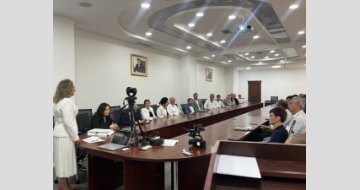Events and press releases

As noted earlier, the Republican Design Institute "UzEngineering", with the involvement of the Association of Consulting Engineers of Uzbekistan, systematically conducts practical work to improve the skills of engineering personnel in the field of design, with the involvement of leading specialists and design engineers from foreign engineering companies.
As part of the performance of these works, close cooperation is carried out with the SES Foundation (Senior Experten Service, Germany) by involving foreign experts to train domestic specialists and exchange experience in various areas of both design and project management.
From March 30 to April 16 this year in "UzEngineering" RDI and technical universities in Tashkent: Turin Polytechnic University, Tashkent State Technical University, Yeoju Technical Institute, a number of trainings and master classes were held with the participation of an expert invited from Germany - Sabina Altmann.
The expert is a specialist in solar technologies, small hydropower, operation of small wind turbines, biogas, with practical experience in implementing projects using renewable energy sources. Directly participated in the implementation of projects in the USA, Turkey, Uganda, Kenya, Tanzania, Nepal and Indonesia.
Below is an interview with Sabina Altmann on the introduction and use of alternative energy in Uzbekistan.
Good day, Sabina. We are glad to welcome you in Uzbekistan. Thank you for agreeing to participate in our interview.
Good day, the pleasure is all mine.
Can you please tell our readers about the SES Foundation, which you represent, what is its main mission and goals?
The Senior Expert Service, SES, is a foundation of the German Industry. The goal of the SES is to send experts from different areas of the German industry to other countries for knowledge transfer. It’s a non-profit organization. Since 1983, the SES has completed over 60,000 voluntary expert assignments in over 160 countries. The SES is based in Bonn and it has about 200 representatives in 93 countries around the world.
Let switch to the main topic. In recent years, Uzbekistan has been systematically working on the development of green energy, in particular, the construction of solar photovoltaic plants and wind farms. By the way, over the past 3 years 10 cooperation agreements have been signed with international. During this short period of time, the President of our country signed 9 executive orders regarding construction of the wind and PV parks. What will it give our country?
What I notice is that Uzbekistan is a very modern country with a lot of building activity all around, especially in Tashkent. This is a good environment for a positive climate towards renewable energies. Fossil fuels are limited and there are the threats of climate change. And the adoption of such measures by the Government of your country is very timely and effective, and thus creates incentives to increase the share of renewable energy sources.
In one well-known publication we found a list of the negative aspects of alternative energy, in particular, solar. E.g. high cost (high costs are required at the initial stage, low power per square meter of the area used (we are talking about the average power density per square meter, and the amount of energy that can be yield from a unit of area. For solar energy, this indicator in average is equal to 170 W/m2, this value is greater than for the all other renewable energy sources, but in comparison with traditional energy sources (oil, coal, gas, nuclear energy), this indicator is much lower), problems of energy storage (relatively high cost of batteries), as well as use of expensive rare earth-elements and other. To what extent these conclusions are valid?
Well, from the scientific studies I know, I cannot fully agree. With costs of 2 to 6 Euro- Cents per kWh for solar installations and 4 to 8 Euro-Cents per kWh for wind power plants according to the German Fraunhofer institute renewables are much cheaper than new coal or nuclear power plants. As for the yield per unit area I think this should not be a criteria because even in a densely populated country like Germany there is enough space for a 100 % renewable power supply, so will be – as I believe – in Uzbekistan. The question should rather be: can we go on with using fossil fuels and all negative effects they are causing. Even traditional oil countries like the Emirates and Saudi Arabia are hugely investing into renewable energies because they have understood that this is the future. Concerning the batteries, yes, there are some issues which have to be solved. For the time being, until Uzbekistan reaches a 50 % renewable share like Germany, I suggest just to install wind and solar power parks and wait for battery innovations which surely will come with growing demand.
"Alternative" energy, as a whole, is not environmentally safe. According to experts, in the areas of PV parks operation the average temperature decreases by about 5 degrees, which negatively affects the flora and fauna. In addition, there is a negative impact on humans by toxic agent vapors used in the operation of sunlight converters. What arguments can be given in favor of using?
In our company we have built over 100 solar installations also a big number of solar power parks which we monitor and maintain. We are visiting our solar parks on a regular basis and a temperature rise could not be monitored. As for the environmental effects of solar parks: compared with agricultural use of the land a solar power park has positive effects on flora and fauna, which means that there are more different species to be found and also species which are threatened by extinction can be found in solar parks. There are several scientific studies in Germany which underline this benefit.
Some sources claim that there are problems with the use of wind farms. Their placement requires large areas. Birds die because of direct collision with wind turbines. Low-frequency vibrations transmitted through the soil negatively affect the animal world. In addition, the problem of constant replacement and disposal of blades is also important. At the same time, many European countries have already banned their storage on their territory. USA exports 80% of used solar and wind parks to the Asia and Africa. There is also an economic side to this issue. Wind energy remains one of the most expensive sources. Are these judgements valid?
Of course the installation of wind power plants needs space. Like any other power plant. Also for mining coal and uranium as well as for oil production large areas are denaturized and contaminated. In comparison with the effect of human activities related to the use of fossil fuels the environmental effect of solar and wind power plants is much smaller. It is true that birds can collide with wind power plants, but the real threat of reduction of species diversity comes from the climate change. About 80 to 90 % of all components of solar and wind power parks can be recycled. Momentarily there is still a high demand for used wind power plants in Africa and Asia – which from an environmental point of view is even better then recycling because these plants still have many years to produce renewable energy. As the blades are composites, they momentarily cannot be recycled but a lot of research work is done to make this possible in future. You have also to take into account that the lifetime of wind and solar installations is 20 to 30 years. So, you have to compare this end-of-life treatment of the components with the recycling rate of other industrial devices. It is important to measure with the same measure.
Sabina, one more tricky question. Recently, Europe has faced an energy crisis. In particular, due to the fact that so-called "green" or "alternative" energy has failed consumers during the absence of sun and wind. How reliable are alternative energy sources, will they fail and pose a threat to Uzbekistan's energy security?
Actually, the European power grid is one of the safest and most reliable in the world, despite of the high percentage of renewables. I do also not remember an energy crisis caused by renewable energies. The energy crisis we are facing momentarily in Europe is caused by fossil energies and because this is known now, many efforts are made to replace natural gas and oil by renewables. But of course, as solar and wind energy are fluctuating and decentralized, measures have to be taken to protect the grid and provide enough energy for the time when there is no solar and wind energy available. Hydrogen produced by renewables is one of the energy carriers which will play an important role in the future. So, my advice for Uzbekistan: it is important to make a plan for the energy transition and take these points into account.
Speaking of renewable energy sources, it is nearly impossible not to mention tidal and hydrothermal stations, as well as biofuel. What can you say about it?
About marine energy and bio fuel from food crops: momentarily these energy sources play no role in our energy supply and also not in the German studies for a energy transition to 100 % renewables – with marine energy this may change in the future, as a lot of research work is done on this field.
Uzbekistan has set a goal to increase the share of renewable energy sources (RES) in the total yield of electrical generation up to 25% by 2030, today it's 10 percent. To achieve this goal, the Ministry of Energy of the Republic of Uzbekistan is taking active measures on implementation of major projects in the field of renewable energy sources. In your opinion, what percentage is the most realistic and practical, from the point of view of energy security and environmental safety?
I already talked about scientific studies on the field of implementing renewable energies into the power supply. In Germany the current share of renewable energies in the power supply is 50.5 %. And the goal for 2045 is to completely avoid CO2 emissions from the energy supply. So my suggestion is to make a more ambitious plan: set higher goals and accompany them with measures to secure grid stability and a continuous power supply as stated above.
Within fair market and political environment, where real price of traditional energy sources is obvious to the consumer, will alternative energy sources be more competitive and attractive to investors without "feed-in tariffs"?
As you know the German feed-in tariff was needed to bring renewable energy technology to market maturity. Now with wind and solar energy being less expensive than energy from fossil fuels there are more and more projects without feed-in tariffs. But if you speak of real prices, it is also important not to subsidize the power price. In a market economy renewable energies are competitive now.
Will the widespread use of alternative energy lead to a reduction of jobs in the traditional energy sector? Will the reduction of existing jobs compensated by creation of the new ones?
Yes, there are many jobs in the renewable industry which will more than compensate for the loss in the old energy sector.
And what about seasonal issues of renewable energy usage? E.g., solar energy production has the highest output in June and falls down in December-February. The Hydropower plant has the highest output in the spring, but the yield often varies year-to-year. Wind energy is very variable, both year-to-year and month-to-month.
The economy cannot manage multiple starts and stops of electricity supply. What can be done to solve this issue?
This is the topic of a German study from the Fraunhofer institute called “Paths to a climate neutral energy system”. The main results are that the fluctuating renewable energies in times of high energy yields must be used to produce chemical energy carriers like hydrogen as well as to store energy as potential energy in water storage plants, as electrical energy in batteries and as heat in huge heating grids. This energy can then be used in times with lower renewable energy supply.
And the last question. Your trainings and master classes held in Tashkent were attended by representatives of both the design and construction areas, as well as students - future engineers. How would you rate the audience you worked with?
You know, based on my experience of visiting different countries as an expert, I come across different people every time, and in my opinion, engineers, both current and future, I mean students, are always distinguished by the desire to gain more knowledge than I transmit as part of the training program or events provided for during the visit. And Uzbekistan is no exception in this respect. A lot of interesting and topical questions, a desire to find out “how are they doing?”, and sometimes I left the audience hours after the end of the training, because everyone had to answer… We managed to captivate the audience, we spoke almost the same language listeners, based on the questions they ask and the answers and comments they heard to mine, at a decent level... It's very nice to share experience and knowledge when genuine interest is shown on the part of listeners and participants. Generally speaking, the trainings were, in my opinion, very effective both for the trainees and for me personally.
Sabina, thank you for the detailed interview. We hope to see you again in Uzbekistan for another experience exchange.
Thank you for your hospitality and also for these very interesting questions!
PS.:
For our readers, we additionally inform that there is an ongoing systematic work to develop green energy in Uzbekistan. The construction of solar photovoltaic parks (PVP) and wind parks (WP), in particular.
As a result of the planned work, in 2022 it is planned to sign project agreements for the construction of 8 solar photovoltaic plants with a total capacity of 1,900 MWp in Bukhara, Namangan, Khorezm, Kashkadarya, Ferghana and other regions, as well as wind farms with a total capacity of 1,700 MW in the Republic of Karakalpakstan.
In 2023, it is planned to commission 4 solar photovoltaic power plants with a total capacity of 1,097 MW in the Samarkand, Jizzakh, Navoi and Surkhandarya regions and 4 wind farms with a total capacity of 1,600 MW in the Republic of Karakalpakstan, Bukhara and Navoi regions.
By 2026, the total capacity of PVP in Uzbekistan is gonna reach 4,000 MWp, total capacity of WP is also gonna reach 4,000 MW. Thus, 25% of total power generation in the Uzbekistan is going to be renewable energy.
In 2022-2026 15 new hydro power plants will be constructed in the Samarkand, Surkhandarya, Tashkent, Kashkadarya, Namangan and Andijan regions. Also, 5 running hydro power plants will be retrofitted.
As a result, 868 MW of additional power yield will be generated. Thanks to ongoing works, by 2026 the total capacity of hydropower plants in Uzbekistan will reach 2,920 MW.





